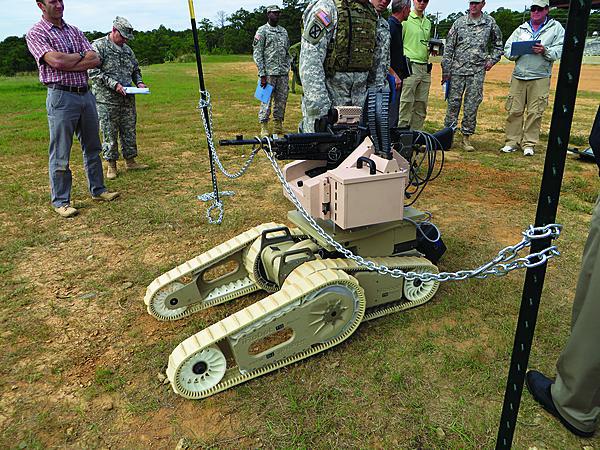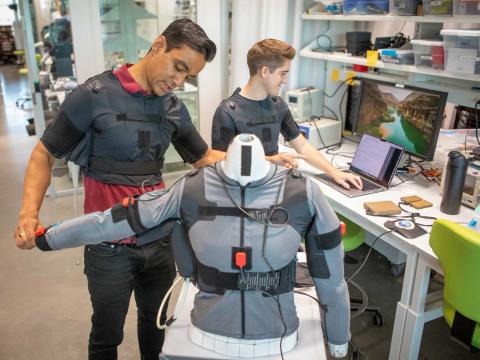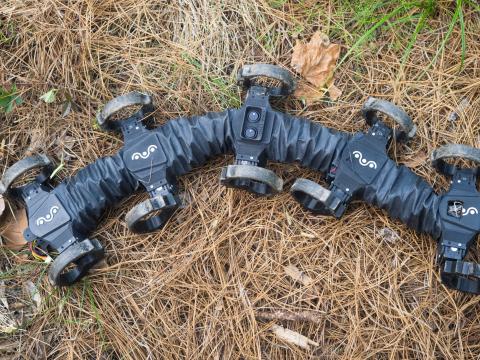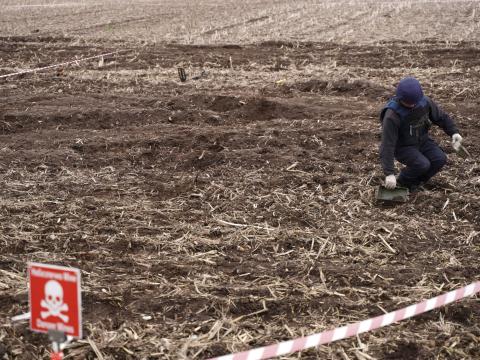Army Tests Ground Robots
The U.S. Army is looking at the current state of the art in ground robots to revise its requirements for a future unmanned squad support platform. A number of robots were recently evaluated by the service to collect data on their ability to carry supplies, follow infantry over rough terrain and fire weapons in a tactical environment. Army officials say the results of this demonstration will help refine the service’s operational needs and goals before the Army considers launching a procurement program.
Combat experience in the rugged mountains of Afghanistan has highlighted the need for systems to help lighten soldiers’ loads. But any potential unmanned ground systems (UGS) capable of carrying a nine-man infantry squad’s equipment will have to be able to keep up with troops as they maneuver in the field and operate for hours or days without refueling. The ability of current UGS systems to meet the Army’s needs was put to the test at the Robotics Limited Demonstration, held by the U.S. Army Maneuver Center of Excellence at Fort Benning, Georgia, October 7-10, 2013.
The intent behind the event was to look at the current state of the art in UGS platforms capable of carrying an infantry squad’s equipment, says Keith Singleton, unmanned systems team chief at the center’s Maneuver Battle Lab. He explains that the center’s development department wanted to make sure what was in the Army’s requirements document matched what commercial firms and research facilities had available and to suggest any revisions based on the collected new data.
While the Army is interested in evaluating the current state of robotic systems for a possible squad support platform, Singleton emphasizes that the demonstration is not part of an acquisition program, but merely an effort to get a picture of what is currently available and technically possible and including any new data into existing requirements.
Eight robots participated in the Squad-Multipurpose Equipment Transport (S-MET) course and four in a live fire exercise (see box). Many ground robots are available, either on the market or in development, but Singleton notes that because of budget and travel restrictions, only a few firms and organizations could participate in the event.
S-MET consisted of a round robin event with four stations for the robots to stop at and perform specific operational/support functions. The first station tested the UGV’s operation and control systems. Each robot was programmed to navigate along a set of waypoints, says James Falkenberry, a project officer on the Unmanned Systems Team at the Maneuver Battle Lab. The second station evaluated the power/recharge requirements for each platform. One goal is the ability for a platform to recharge warfighters’ equipment, such as radio batteries, he adds.
The third station examined each robot’s load-bearing capability—a key factor for a squad support platform. UGVs were evaluated for how much weight they could carry and how fast they could go with a full load, says Falkenberry. Each machine was loaded with enough supplies to support a squad in the field for 72 hours. This included seven rucksacks filled with supplies and ammunition, one ruggedized plastic cargo container for communications equipment, water and other gear to support the unit, totaling 1,000 pounds. A key part of this evaluation centered on determining if the units could carry the required weight and if they had enough cubic space on the platform, he explains.
Once they were fully loaded, the UGVs went to the speed track for the second phase of this station’s evaluation. The loaded robots were placed in a single lane and accelerated to top speed to determine how fast they could move with a full load. At full speed, the evaluators then activated an emergency stop command to measure how long and how much distance it took each platform to stop, Falkenberry says.
The final station was a maneuver course to test how nimble each platform was. A key part of the course tested the UGVs ability to go up and down steep slopes and to move horizontally along a 30-degree incline without tipping over, Falkenberry says. To simulate varying missions, each of these tests was conducted with different load and weight configurations, he added.
After the robots had finished with the four stations, they moved on to a maneuver and mobility course. The goal was to examine how much fuel and or/power each platform used under different equipment loads. Army evaluators also examined how well each UGV performed when maneuvering with full loads through rough terrain such as high vegetation and gullies, Falkenberry explains.
During this part of the demonstration, each of the robots was stopped at the midpoint of the course and programmed with a new set of waypoints to follow to exit the course. The waypoints led to a final set of obstacles, a water crossing and then passage through a rocky culvert, Falkenberry says.
Another key part of the event was determining how effective the machines were at leader/follower systems. This technology consists of a handheld controller or a device worn on a soldier’s belt that the robot then follows at a certain distance. If the soldier stops, the robot will stop. If the soldier moves around and through underbrush and obstacles, the robot will follow, altering its course if necessary to maneuver around an object. Falkenberry notes that the control device is intended to allow soldiers to do their jobs and keep their hands on their weapon while the robot automatically follows.
The demonstration highlighted several issues about the current state of UGV technology. The first is that no single UGV has all the answers to the service’s needs, Falkenberry relates. Another issue is that leader/follower technology still needs refinement. The Army’s goal is for soldiers wearing the control device to be able to do their jobs in combat and not have to constantly mind the UGVs. The UGVs would automatically follow and carry out any direct commands as instructed. But the technology still needs work. “It’s not at that point, based on what we saw, that the soldier doesn’t have to personally intervene,” he says.
The leader/follower evaluations were held in “infantry” terrain for dismounted soldiers, consisting of gullies, tall vegetation and woods. Falkenberry notes that in this terrain, infantry picked routes that would best suit their mission, using the terrain to their advantage. However, the vendors often chose routes best suited for the platform to travel on, not soldiers, he observes. These routes were often not as desirable for troops to take.
As with the S-MET evaluation, the goal of the live-fire event was to check the state of UGV technology currently available on the market, Falkenberry says. The robots’ weapons were fired remotely by soldiers using a wireless controller. The UGVs fired at pop-up targets at a range of 150 to 200 meters. Each platform’s weapon was bore-sighted and evaluated on how difficult it was for soldiers to sight the weapon and the ease of loading/unloading, he explains. Most of the UGVs were equipped with a remote weapons station using electro-optic, thermal and infrared sights—all systems that give gunners operating them a major advantage over those using unenhanced sighting systems, he observes.
Each robot fired 50 to 100 rounds per target and was evaluated for its general accuracy. Falkenberry notes that the platforms tested could be equipped with a variety of weapons, but the Army wanted to keep the process simple and fitted each one with a single M-240 machine gun.
At press time, the Army still was tabulating the data collected from the demonstration. Once the information is complete, it will be used to upgrade the Army’s current capabilities document on the state of UGVs. The collected data then is moved up the service’s hierarchy where it may be used as material for a future acquisitions program, explains Lt. Col. David Smith, robotics branch chief, Maneuver Center of Excellence, and chief of the unmanned ground systems branch. However, he maintains, this event is merely an open query to industry to see what it has that meets Army criteria. “You never know what’s out there that’s going to meet your requirement,” he explains.





Comments